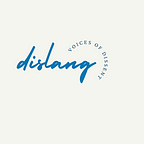Notes from Transition
Kavya Poornima Balajepalli
In the month of August 2017, during my final year Architecture in Mumbai, I suffered sudden vision loss in both my eyes due to a rare chronic neurological disorder called Idiopathic Intracranial Hypertension, also known as IIH. Everything has changed now.
Invisible battles
Travelling was once a part of my life. But that too has changed completely. My disability has made me sacrifice most of my interests and travel was one of them. Air travel is the only safe and fastest travel option for my vulnerable state. At least that’s what I thought until the day I travelled. I understood how difficult it was to convince the staff at the security check to avoid the use of Magnetometer/ Metal Detector and do the check manually as I have a Shunt implant in my brain which gets disturbed by the magnetic field. Travelling was now overwhelming because the shunt was invisible just like the rare Chronic Neurological disorder (IIH) is.
Adapting
Neither my visual disability is considered significant, nor my neurological condition is visible, which made it difficult for me to make people understand that I have a disability. For example, whenever I travel, my mother accompanies me as my caregiver and at times it is challenging for her to navigate me through a crowd.
Since ableism paints disability in a certain way, I decided to use that to subvert how I was seen in a crowd. I started learning to use a white cane, to carry it wherever I travel to avoid unnecessary conversations, more to be recognized by the public as a visually impaired person although it doesn’t help me much since there are inaccessible roads, potholes, uneven surfaces everywhere which become a threat for my brain shunt implant.
Shifting base
After acquiring Disability, I moved to a bigger city with the hope of accessing good healthcare, better connectivity, and online facilities where using apps for basic needs could make my disabled life easier. Being completely dependent on these apps for Daily needs like grocery and medicines has become part of my life. I often face several issues as the app interfaces are not user friendly, descriptions provided for the product are never accurate, returning or exchanging becomes a major issue apart from the delivery. Seeking help from my mother always becomes challenging because it reminds me of my dependency. There are various apps for different purposes in the market for the visually disabled, but most of them are confusing for me as a person who acquired vision impairment late in life. I take such experiences as an opportunity to turn my experiences into an advocacy tool, to complain about inaccessibility and sensitize the service providers.
Why can’t we have apps designed for the disabled? Why can’t there be a set of standardized applications that can accommodate all the needs of a visually disabled person? Why can’t they be available for free?
Many Questions
I was asked to quit architecture when I acquired my disability because they could not provide reasonable accommodations, and this continues even after completing my graduation.
The nature of my disability is in contrast to my professional background, or so I am told. I am sick of the discouragement from various people with respect to my work in Architecture and questioning all of my ambitions because of my visual disability.
According to the Architecture fraternity and the Disability community, it is impossible as I cannot see, and I cannot use the architectural softwares even after learning from a screen reader because they are not compatible. I am still being judged and advised to change my career path.
The Path ahead
As much as I embrace my disability, I do blame myself for instances like these. Living with a disability is not always meant to be inspiring, rather, it is all about accepting and including.
There were days when I felt bad about people talking about me as if I am incapable of doing things. Being a disabled woman, you are considered to be a mismatch as you don’t fit into the ‘bahu’ standards set by the society. I also feel sorry for those families who were once competing for me for their sons, just vanished after my acquired disability. People suggest to my family that they get me married to someone “who is like me” or someone who will marry me as a sign of “goodwill”.
Uncertainties are real and can happen at any point of time. Acquiring disability isn’t something I could have control over. I can control how I react to this sudden shift and adapt to coexist with things as they are.That is something that keeps me moving. We can only control the controllable, that’s how life is.
I am exploring my second phase of life by exploring new dimensions. I want to make living out of things I am passionate about irrespective of the acceptance that people have for me. The love hate relationship with my disabled life continues.
Kavya is an architect, a trained Bharatanatyam dancer, an art enthusiast, who is always on the lookout for exciting activities while exploring her second phase of life through a keyhole. She is currently engaged with NCPEDP as a Javed Abidi Fellow on Disability. She curates a blog site “Poornamidam” focusing on Architecture, Disability and Accessibility-related issues.
